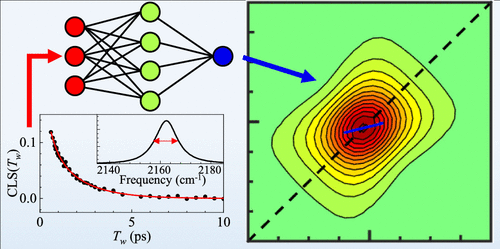当前位置:
X-MOL 学术
›
J. Phys. Chem. A
›
论文详情
Our official English website, www.x-mol.net, welcomes your
feedback! (Note: you will need to create a separate account there.)
CLS Next Gen: Accurate Frequency-Frequency Correlation Functions from Center Line Slope Analysis of 2D Correlation Spectra Using Artificial Neural Networks.
The Journal of Physical Chemistry A ( IF 2.7 ) Pub Date : 2020-06-18 , DOI: 10.1021/acs.jpca.0c04313 David J Hoffman 1 , Michael D Fayer 1
The Journal of Physical Chemistry A ( IF 2.7 ) Pub Date : 2020-06-18 , DOI: 10.1021/acs.jpca.0c04313 David J Hoffman 1 , Michael D Fayer 1
Affiliation

|
The center line slope (CLS) observable has become a popular method for characterizing spectral diffusion dynamics in two-dimensional (2D) correlation spectroscopy because of its ease of implementation, robustness, and clear theoretical relationship to the frequency–frequency correlation function (FFCF). The FFCF relates the frequency fluctuations of an ensemble of chromophores to coupled bath modes of the chemical system and is used for comparison to molecular dynamics simulations and for calculating 2D spectra. While in the appropriate limits, the CLS can be shown to be the normalized FFCF, from which the full FFCF can be obtained, in practice the assumptions that relate the CLS to the normalized FFCF are frequently violated. These violations are due to the presence of homogeneous broadening and motional narrowing. The generalized problem of relating the CLS to the FFCF is reanalyzed by introducing a new set of dimensionless parameters for both the CLS and FFCF. A large data set was generated of CLS parameters derived from numerically modeled 2D line shapes with known FFCF parameters. This data set was used to train feedforward artificial neural networks that act as functions, which take the CLS parameters as inputs and return FFCF parameters. These neural networks were deployed in an algorithm that is able to quickly and accurately determine FFCF parameters from experimental CLS parameters and the fwhm of the absorption line shape. The method and necessary inputs to accurately obtain the FFCF from the CLS are presented.
中文翻译:

下一代CLS:使用人工神经网络从二维相关光谱的中心线斜率分析获得准确的频率-频率相关函数。
可观察到的中心线斜率(CLS)已成为表征二维(2D)相关光谱中光谱扩散动力学特征的流行方法,因为它易于实现,鲁棒性强,并且与频率-频率相关函数(FFCF)有着清晰的理论关系。FFCF将生色团整体的频率波动与化学系统的耦合浴模式相关联,并用于与分子动力学模拟进行比较以及计算2D光谱。尽管在适当的范围内,CLS可以显示为归一化的FFCF,从中可以获取完整的FFCF,但在实践中经常违反将CLS与归一化的FFCF相关的假设。这些违规行为是由于存在均匀的展宽和运动的变窄。通过为CLS和FFCF引入一组新的无量纲参数,可以重新分析将CLS与FFCF相关联的普遍问题。从具有已知FFCF参数的数值建模2D线形中得出的CLS参数生成了大量数据集。该数据集用于训练充当函数的前馈人工神经网络,该网络将CLS参数作为输入并返回FFCF参数。这些神经网络被部署在一种算法中,该算法能够根据实验性CLS参数和吸收线形状的一半快速而准确地确定FFCF参数。提出了从CLS准确获取FFCF的方法和必要的输入。从具有已知FFCF参数的数值建模2D线形中得出的CLS参数生成了大量数据集。该数据集用于训练充当函数的前馈人工神经网络,该网络将CLS参数作为输入并返回FFCF参数。这些神经网络被部署在一种算法中,该算法能够根据实验性CLS参数和吸收线形状的一半快速而准确地确定FFCF参数。提出了从CLS准确获取FFCF的方法和必要的输入。从具有已知FFCF参数的数值建模2D线形中得出的CLS参数生成了大量数据集。该数据集用于训练充当功能的前馈人工神经网络,该网络将CLS参数作为输入并返回FFCF参数。这些神经网络被部署在一种算法中,该算法能够根据实验CLS参数和吸收线形状的半数快速而准确地确定FFCF参数。提出了从CLS准确获取FFCF的方法和必要的输入。将这些神经网络部署在一种算法中,该算法能够根据实验CLS参数和吸收线形状的半数快速而准确地确定FFCF参数。提出了从CLS准确获取FFCF的方法和必要的输入。这些神经网络被部署在一种算法中,该算法能够根据实验性CLS参数和吸收线形状的一半快速而准确地确定FFCF参数。提出了从CLS准确获取FFCF的方法和必要的输入。
更新日期:2020-07-16
中文翻译:

下一代CLS:使用人工神经网络从二维相关光谱的中心线斜率分析获得准确的频率-频率相关函数。
可观察到的中心线斜率(CLS)已成为表征二维(2D)相关光谱中光谱扩散动力学特征的流行方法,因为它易于实现,鲁棒性强,并且与频率-频率相关函数(FFCF)有着清晰的理论关系。FFCF将生色团整体的频率波动与化学系统的耦合浴模式相关联,并用于与分子动力学模拟进行比较以及计算2D光谱。尽管在适当的范围内,CLS可以显示为归一化的FFCF,从中可以获取完整的FFCF,但在实践中经常违反将CLS与归一化的FFCF相关的假设。这些违规行为是由于存在均匀的展宽和运动的变窄。通过为CLS和FFCF引入一组新的无量纲参数,可以重新分析将CLS与FFCF相关联的普遍问题。从具有已知FFCF参数的数值建模2D线形中得出的CLS参数生成了大量数据集。该数据集用于训练充当函数的前馈人工神经网络,该网络将CLS参数作为输入并返回FFCF参数。这些神经网络被部署在一种算法中,该算法能够根据实验性CLS参数和吸收线形状的一半快速而准确地确定FFCF参数。提出了从CLS准确获取FFCF的方法和必要的输入。从具有已知FFCF参数的数值建模2D线形中得出的CLS参数生成了大量数据集。该数据集用于训练充当函数的前馈人工神经网络,该网络将CLS参数作为输入并返回FFCF参数。这些神经网络被部署在一种算法中,该算法能够根据实验性CLS参数和吸收线形状的一半快速而准确地确定FFCF参数。提出了从CLS准确获取FFCF的方法和必要的输入。从具有已知FFCF参数的数值建模2D线形中得出的CLS参数生成了大量数据集。该数据集用于训练充当功能的前馈人工神经网络,该网络将CLS参数作为输入并返回FFCF参数。这些神经网络被部署在一种算法中,该算法能够根据实验CLS参数和吸收线形状的半数快速而准确地确定FFCF参数。提出了从CLS准确获取FFCF的方法和必要的输入。将这些神经网络部署在一种算法中,该算法能够根据实验CLS参数和吸收线形状的半数快速而准确地确定FFCF参数。提出了从CLS准确获取FFCF的方法和必要的输入。这些神经网络被部署在一种算法中,该算法能够根据实验性CLS参数和吸收线形状的一半快速而准确地确定FFCF参数。提出了从CLS准确获取FFCF的方法和必要的输入。











































 京公网安备 11010802027423号
京公网安备 11010802027423号